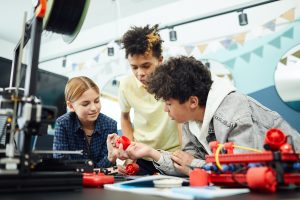Spanish Level 4- Face-to-Face Activities
🧑🔧 Spanish Level 4, Activity 06: Invenciones creativas / Creative Inventions (Face-To-Face)

Semantic Topics: Shark Tank, inventions, creative, useful, technology, investment, invenciones, invención, creatividad, tecnología, inversión
Grammatical Structures: Future tense, future perfect tense, el futuro, el futuro perfecto
Products: Inventions and products from Spanish-speaking cultures
Practices: Inventing new products, marketing and selling invented products, working together in groups
Perspectives: Value of entrepreneurship and creativity
- Standard 1.1 – Students engage in conversations, provide and obtain information, express feelings and emotions, and exchange opinions.
- Standard 1.2 – Students understand and interpret spoken and written Spanish on a variety of topics.
- Standard 1.3 – Students present information, concepts, and ideas in Spanish to an audience of listeners or readers on a variety of topics.
- Standard 2.2 – Students demonstrate an understanding of the relationship between the products and perspectives of Hispanic cultures.
- Standard 3.1 – Students reinforce and further their knowledge of other disciplines through Spanish.
Idaho Content Standards for World Languages:
- COMM 1.1 – Interact and negotiate meaning (spoken, signed, written conversation) to share information, reactions, feelings, and opinions
- COMM 2.1 – Understand, interpret, and analyze what is heard, read, or viewed on a variety of topics.
- COMM 3.1 – Present information, concepts, and ideas to inform, explain, persuade, and narrate on a variety of topics using appropriate media in the target language.
- CLTR 2.1- Analyze the significance of a product (art, music, literature, etc…) in a target culture.
- COMP 2.1- Identify, describe and compare/contrast products and their use in the target culture with the learner’s culture.
NCSSFL-ACTFL Can-Do Statements:
- I can describe a product from a Spanish speaking country in order to sell it (intercultural)
- I can provide reasons to support an argument.
- I can exchange preferences.
- I can talk about products related to everyday life.
Materials Needed:
- Google Slide Presentation (hyperlinked)
- Paper/pencil
Warm-Up
- Begin by opening the Google Slideshow and introducing the Can-Do’s.
Hola, ¿cómo están? Estoy ____. Vamos a empezar el lab de hoy con los can-do statements. - For the warmup you will open up products that hispanic/latino inventors made
Van a tratar de vender los productos que hicieron los inventores hispanos/latinos
Main Activity
- In groups of two, students will have 10 minutes to create an invention. They will then present the product to the class. As the instructor, you will play the role of the shark and choose the product you want to invest in.
Han visto el programa Shark Tank? Hay un programa similar en España que se llama Tu oportunidad. Tu oportunidad les han invitado a presentar una invención ó tecnología nueva. Uds. van a trabajar en parejas por 10 minutos para crear una invención nueva. Después, van a presentar las ideas al “tiburón.” Yo soy el tiburón (Lab assistant) y voy a elegir el producto en cual quiero invertir. - The students must make sure that their product has the details included on the slide:
- El nombre del producto (Name of the product)
- ¿Qué hace el producto? (What does the product do?)
- ¿Cómo va a mejorar la vida diaria? (How will your daily life improve?)
- ¿Cuánto dinero cuesta la invención? (How much does its invention cost?)
- ¿Por qué se debe invertir dinero en su invención? (Why should you invest money into the invention?)
- Ejemplos: Puede ser un app, producto, sitio de web, una herramienta…
- Each pair will present their inventions to the group. The instructor chooses the one that he/she would like to invest in.
Ahora van a presentar su invención ó tecnología al grupo. He elegido invertir en …
Wrap-Up
- Ask the following questions to your students to finish the lab:
- ¿Cuál fue tu invención favorita del grupo y por qué? (Which was your favorite invention and why?)
- ¿Por qué es importante saber alguna terminología de tecnología en español? (Why is it important to know some terminology of technology in Spanish?)
End of Lab
- Read Can-Do statements once more and have students evaluate
their confidence.
(Use thumbs up/thumbs down or download our student cards.) - Encourage students to be honest in their self-evaluation.
- Pay attention, and try to use feedback for future labs!
NCSSFL-ACTFL Can-Do Statements:
- I can describe objects and the benefits they have. (Intercultural)
- I can provide reasons to support an argument.
- I can exchange preferences.
- I can talk about products related to everyday life.
CULTURAL NOTES:
Famous Groundbreaking Inventions by Latino Inventors
10 Spanish Inventors Who Have Changed Your Life
How to Revise or Remix a Pathways Project Activity
Feeling creative? The Pathways Project needs your help in revising and remixing activities for the K-16 language classroom.
Try taking an activity to the next level by:
- Add new content (something you’ve created or another OER source)
- Contribute additional activity suggestions
- Integrate authentic materials such as videos, infographics, photos, etc.
- Suggest how to implement the activity in the classroom
- Customize the content for a specific audience or group of learners (for example, K-5 learners or to differentiate for student’s needs)

